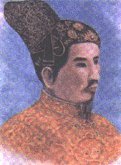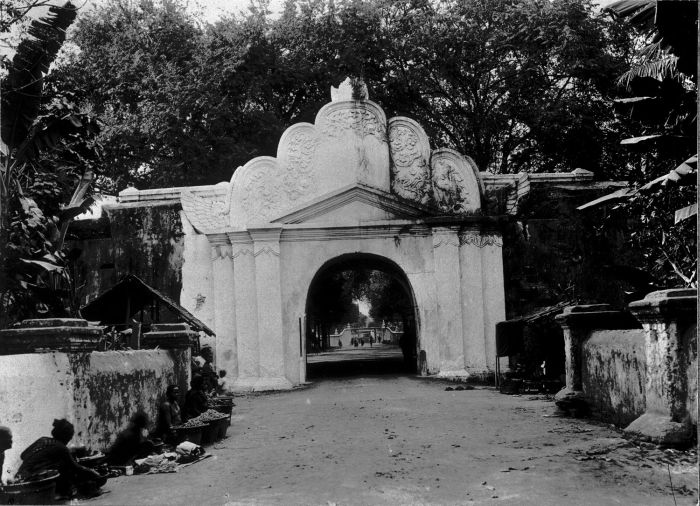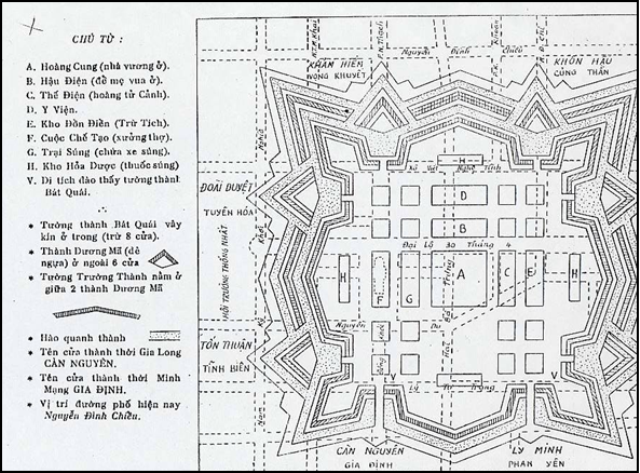|
Citadel Of Saigon
The Citadel of Saigon ( vi, Thành Sài Gòn ) also known as the Citadel of Gia Định ( vi, Thành Gia Định ) was a late 18th-century fortress that stood in Saigon (also known in the 19th century as Gia Định, now Ho Chi Minh City), Vietnam from its construction in 1790 until its destruction in February 1859. The citadel was only used once prior to its destruction, when it was captured by Lê Văn Khôi in 1833 and used in a revolt against Emperor Minh Mạng. It was destroyed in a French naval bombardment as part of the colonization of southern Vietnam which became the French colony of Cochinchina. In the late 18th century, the city of Saigon was the subject of warfare between the Tây Sơn dynasty, which had toppled the Nguyễn lords who ruled southern Vietnam, and Nguyễn Ánh, the nephew of the last Nguyễn lord. The city changed hands multiple times before Nguyễn Ánh captured the city in 1789. Under the directions of French officers recruited for him, a V ... [...More Info...] [...Related Items...] OR: [Wikipedia] [Google] [Baidu] |
Ho Chi Minh City
, population_density_km2 = 4,292 , population_density_metro_km2 = 697.2 , population_demonym = Saigonese , blank_name = GRP (Nominal) , blank_info = 2019 , blank1_name = – Total , blank1_info = US$61.7 billion , blank2_name = – Per capita , blank2_info = US$6,862 , blank3_name = GRP ( PPP) , blank3_info = 2019 , blank4_name = – Total , blank4_info = US$190.3 billion , blank5_name = – Per capita , blank5_info = US$21,163 , blank6_name = HDI (2020) , blank6_info = 0.795 ( 2nd) , area_code = 28 , area_code_type = Area codes , website = , timezone = ICT , utc_offset = +07:00 , postal_code_type = Postal code , postal_code = 700000–740000 , iso_code ... [...More Info...] [...Related Items...] OR: [Wikipedia] [Google] [Baidu] |
Lê Văn Duyệt
Lê Văn Duyệt)., group=n (1763 or 1764 – 30 July 1832) was a Vietnamese general who helped Nguyễn Ánh—the future Emperor Gia Long—put down the Tây Sơn wars, unify Vietnam and establish the Nguyễn dynasty. After the Nguyễn came to power in 1802, Duyệt became a high-ranking mandarin, serving under the first two Nguyễn emperors Gia Long and Minh Mạng.Nghia M. Vo ''Saigon: A History'' – Page 46 2011 Born into a family of peasants near Tiền Giang, Duyệt joined Prince Nguyễn Ánh in fighting the Tây Sơn wars. Because of Duyệt's military ability, he quickly rose through the ranks of the Nguyễn army and became a marshal when the Tây Sơn-Nguyễn war ended. After the foundation of the Nguyễn dynasty, Duyệt served as a high-ranking mandarin and, later, viceroy of the southern part of Vietnam, ruling from Gia Định (modern-day Saigon). His governance greatly stabilized and helped develop the Nam Bo region, turning it into a wealthy a ... [...More Info...] [...Related Items...] OR: [Wikipedia] [Google] [Baidu] |
Saigon River
The Saigon River ( vi, Sông Sài Gòn) is a river located in southern Vietnam that rises near Phum Daung in southeastern Cambodia, flows south and south-southeast for about and empties into the Soài Rạp, which in its turn empties into the South China Sea some northeast of the Mekong Delta. The Saigon River is joined northeast of Ho Chi Minh City (formerly named Saigon) by the Đồng Nai river, and just above Ho Chi Minh City it is joined by the Bến Cát River. Saigon River is important to Ho Chi Minh City as it is the main water supply as well as the host of Saigon Port, with a total cargo volume loaded and outloaded of more than 35 million metric tons in 2006. The Bình Quới Tourist Village is located on the Thanh Da peninsula on the Saigon River, in the Bình Thạnh District of Ho Chi Minh City. Thủ Thiêm Tunnel, an underwater tunnel passing below the Saigon River, was opened to traffic on November 20, 2011. Since its completion, it has been the longest ... [...More Info...] [...Related Items...] OR: [Wikipedia] [Google] [Baidu] |
Defensive Wall
A defensive wall is a fortification usually used to protect a city, town or other settlement from potential aggressors. The walls can range from simple palisades or earthworks to extensive military fortifications with towers, bastions and gates for access to the city. From ancient to modern times, they were used to enclose settlements. Generally, these are referred to as city walls or town walls, although there were also walls, such as the Great Wall of China, Walls of Benin, Hadrian's Wall, Anastasian Wall, and the Atlantic Wall, which extended far beyond the borders of a city and were used to enclose regions or mark territorial boundaries. In mountainous terrain, defensive walls such as ''letzis'' were used in combination with castles to seal valleys from potential attack. Beyond their defensive utility, many walls also had important symbolic functions representing the status and independence of the communities they embraced. Existing ancient walls are almost always masonry st ... [...More Info...] [...Related Items...] OR: [Wikipedia] [Google] [Baidu] |
Glacis
A glacis (; ) in military engineering is an artificial slope as part of a medieval castle or in early modern fortresses. They may be constructed of earth as a temporary structure or of stone in more permanent structure. More generally, a glacis is any slope, natural or artificial, which fulfils the above requirements. The etymology of this French word suggests a slope made dangerous with ice, hence the relationship with ''glacier''. A ''glacis plate'' is the sloped front-most section of the hull of a tank or other armoured fighting vehicle. Ancient fortifications A glacis could also appear in ancient fortresses, such as the one the ancient Egyptians built at Semna in Nubia. Here it was used by them to prevent enemy siege engines from weakening defensive walls. Hillforts in Britain started to incorporate glacis around 350 BC. Those at Maiden Castle, Dorset were high. Medieval fortifications Glacis, also called talus, were incorporated into medieval fortifications t ... [...More Info...] [...Related Items...] OR: [Wikipedia] [Google] [Baidu] |
British East India Company
The East India Company (EIC) was an English, and later British, joint-stock company founded in 1600 and dissolved in 1874. It was formed to trade in the Indian Ocean region, initially with the East Indies (the Indian subcontinent and Southeast Asia), and later with East Asia. The company seized control of large parts of the Indian subcontinent, colonised parts of Southeast Asia and Hong Kong. At its peak, the company was the largest corporation in the world. The EIC had its own armed forces in the form of the company's three Presidency armies, totalling about 260,000 soldiers, twice the size of the British army at the time. The operations of the company had a profound effect on the global balance of trade, almost single-handedly reversing the trend of eastward drain of Western bullion, seen since Roman times. Originally chartered as the "Governor and Company of Merchants of London Trading into the East-Indies", the company rose to account for half of the world's trade d ... [...More Info...] [...Related Items...] OR: [Wikipedia] [Google] [Baidu] |
John Crawfurd
John Crawfurd (13 August 1783 – 11 May 1868) was a Scottish physician, colonial administrator, diplomat, and author who served as the second and last Resident of Singapore. Early life He was born on Islay, in Argyll, Scotland, the son of Samuel Crawfurd, a physician, and Margaret Campbell; and was educated at the school in Bowmore. He followed his father's footsteps in the study of medicine and completed his medical course at the University of Edinburgh in 1803, at the age of 20. Crawfurd joined the East India Company, as a Company surgeon, and was posted to India's Northwestern Provinces (now Uttar Pradesh), working in the area around Delhi and Agra from 1803–1808. He saw service in the campaigns of Baron Lake. In the East Indies Crawfurd was sent in 1808 to Penang, where he applied himself to the study of the Malay language and culture. In Penang, he met Stamford Raffles for the first time. In 1811, Crawfurd accompanied Raffles on Lord Minto's Java Invasion, whic ... [...More Info...] [...Related Items...] OR: [Wikipedia] [Google] [Baidu] |
Citadel Of Saigon 1867
A citadel is the core fortified area of a town or city. It may be a castle, fortress, or fortified center. The term is a diminutive of "city", meaning "little city", because it is a smaller part of the city of which it is the defensive core. In a fortification with bastions, the citadel is the strongest part of the system, sometimes well inside the outer walls and bastions, but often forming part of the outer wall for the sake of economy. It is positioned to be the last line of defence, should the enemy breach the other components of the fortification system. The functions of the police and the army, as well as the army barracks were developed in the citadel. History 3300–1300 BC Some of the oldest known structures which have served as citadels were built by the Indus Valley civilisation, where citadels represented a centralised authority. Citadels in Indus Valley were almost 12 meters tall. The purpose of these structures, however, remains debated. Though the structures fo ... [...More Info...] [...Related Items...] OR: [Wikipedia] [Google] [Baidu] |
Citadel Of Saigon Before 1835
A citadel is the core fortified area of a town or city. It may be a castle, fortress, or fortified center. The term is a diminutive of "city", meaning "little city", because it is a smaller part of the city of which it is the defensive core. In a fortification with bastions, the citadel is the strongest part of the system, sometimes well inside the outer walls and bastions, but often forming part of the outer wall for the sake of economy. It is positioned to be the last line of defence, should the enemy breach the other components of the fortification system. The functions of the police and the army, as well as the army barracks were developed in the citadel. History 3300–1300 BC Some of the oldest known structures which have served as citadels were built by the Indus Valley civilisation, where citadels represented a centralised authority. Citadels in Indus Valley were almost 12 meters tall. The purpose of these structures, however, remains debated. Though the structures found ... [...More Info...] [...Related Items...] OR: [Wikipedia] [Google] [Baidu] |
Olivier De Puymanel
Victor Olivier de Puymanel (1768 in Carpentras - 1799 in Malacca), Nguyễn Văn Tín ( 阮 文 信) or Ông Tín in Vietnamese, was a French construction officer and a French Navy volunteer and adventurer who had an important role in Vietnam in the 18th and 19th century. He played a key role in the modernization of the army of Nguyễn Phúc Ánh (the future Emperor Gia Long).Mantienne, p.153 Olivier de Puymanel was second-class volunteer on board the French warship ''Dryade''. In 1788 he deserted his ship while in Pulo Condor. He soon entered into the service of the Vietnamese prince Nguyễn Phúc Ánh at the instigation of Pigneau de Behaine, who was setting up a force of French volunteers to help the latter regain the throne.''The Vietnamese Response to French Intervention'', 1862-1874 by Mark W. McLeod, p.1/ref> Olivier de Puymanel supervised the construction of the Citadel of Saigon, according to the design of the French engineer in Vietnam Théodore Lebrun. He also ... [...More Info...] [...Related Items...] OR: [Wikipedia] [Google] [Baidu] |







.jpg)
